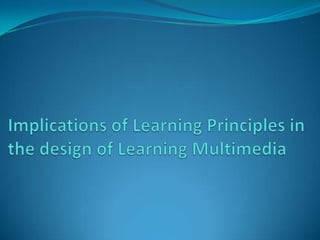Multimedia and learning_principles
•Descargar como PPSX, PDF•
0 recomendaciones•270 vistas
Denunciar
Compartir
Denunciar
Compartir

Recomendados
Recomendados
Más contenido relacionado
La actualidad más candente
La actualidad más candente (20)
Jacob Davidsens presentation "Interaction between learners" at CAL11

Jacob Davidsens presentation "Interaction between learners" at CAL11
Developing Computer Assisted Instruction in the Pythagorean Theorem

Developing Computer Assisted Instruction in the Pythagorean Theorem
Similar a Multimedia and learning_principles
Similar a Multimedia and learning_principles (20)
Sgd imperatives-for quality in digital enviorn-amity-jun-2017

Sgd imperatives-for quality in digital enviorn-amity-jun-2017
Learning theories and their implications on educational technology

Learning theories and their implications on educational technology
Final ExamSection I. Short answer. 1. What are point and n.docx

Final ExamSection I. Short answer. 1. What are point and n.docx
Multimedia and learning_principles
- 1. Implications of Learning Principles in the design of Learning Multimedia
- 2. Why learn about Learning principles Instruction is the application of learning principles. Effective educational materials delivers effective instruction. Multimedia should be used to design effective educational materials.
- 4. Behavioral Psychology Principles Correct responses must be followed up with immediate feedback or reinforcement.Stimuli can be positive or negative. When a stimuli reinforce behavior: provide positive feedback. The learner has learned something when you can observe his behavior Immediate feedback can be given in the form of sounds, animation, color and audio. There should be a score element and an evaluation element
- 6. The learner knows what to expect.
- 7. After an exercise, the exercise can be checked. The sound, animation and color in a program is very important and have to do with the sensory perception of the learner.
- 10. Constructivist Psychology Principles Discovery learning: let learner explore, experiment, research, ask questions and seek answers. Situated learning and anchored instruction: learning occurs in a context, and learning environment should be embedded in a context similar to real world. Adding resources is very essential to multimedia design. Example: web quests Properly design the learning environment to present context of learning
- 11. Constructivist Psychology Principles (cont’d) Reflecting the complexity of the world: better educational environments should be designed with information, problems, and multiple solution approaches. Cooperative and collaborative learning: knowledge is constructed by interaction with others. More multisensory, motivation and metacognition. Design multimedia programs with information, problems, and multiple solution approaches. Multimedia program should use collaborative tools and technology
